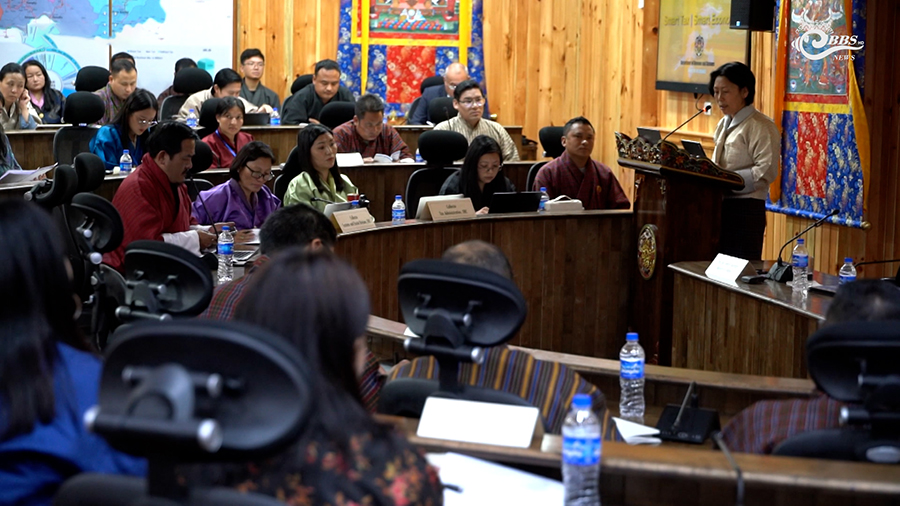Bhutan’s GDP Growth Masks Rising Fiscal and Economic Vulnerabilities

By Yeshi Dolma
While Bhutan’s GDP is projected to grow 8.55% in 2025, the latest Macroeconomic Situation Report reveals deeper challenges, including a widening fiscal deficit, rising debt, and external sector vulnerabilities. Hydropower remains the primary growth engine, but delays in major projects and dependence on borrowing create risks that could undermine the economy’s stability.
The fiscal deficit is expected to widen to 5.21% of GDP in 2025-26 and 5.60% in 2026-27, a significant increase from 2.51% in 2024-25. The rise reflects growth in public expenditure, which continues to outpace revenue mobilization. Total government spending is projected to increase by more than 33%, from Nu. 89.3 billion in 2024-25 to Nu. 119.2 billion in 2025-26. Current expenditure is rising due to higher debt servicing and larger grants to local governments, while capital expenditure, including infrastructure and human resource development, is projected to increase nearly 40%.
An expert cautioned, “Expenditure growth is running well ahead of revenue mobilization, and that imbalance is dangerous over the medium term. It forces the country to rely on borrowing, creating a debt spiral that will only deepen unless structural reforms take hold.”
To address the fiscal gap, the government plans tax reforms, including the introduction of a Goods and Services Tax (GST) in 2026. This is intended to broaden the tax base and reduce market distortions. At the same time, merging Business Income Tax and Personal Income Tax and reducing Corporate Income Tax from 30% to 22% is expected to lower revenue by Nu. 2 billion annually from 2026-27. Early GST projections are modest, at Nu. 14 billion, with implementation challenges likely to limit collections.
Total public debt stood at Nu. 303.97 billion in 2024-25, equivalent to 100.46% of GDP, and is projected to reach Nu. 400.09 billion by 2026-27. Nearly 92% of this debt is external, with hydropower loans accounting for more than half. While these loans are described as “self-liquidating,” their repayment depends on timely hydropower revenue. Delays in projects such as Dorjilung and Khorlochu, with financing agreements now pushed to late 2025 or 2026, increase fiscal risk.
“Hydropower is not a quick fix- it is a high-stakes gamble,” the expert said. “If projects are delayed, the loans still have to be serviced, but the revenue is missing. That mismatch can severely strain the country’s finances and trigger a debt crisis.”
Grants have historically stabilized public finances, accounting for over 22% of resources in 2024-25, mostly from India. However, following Bhutan’s graduation from Least Developed Country status in 2023, preferential aid will gradually decline. The report warns of risks linked to “weakening fiscal autonomy,” signaling increased dependence on borrowing.
The economy is facing a “twin deficit” scenario, with both fiscal and current account deficits (CAD). The CAD is projected at 14.49% of GDP in 2024-25, equivalent to Nu. 43.83 billion, and expected to exceed 21% by 2027-28. A merchandise trade deficit drives the gap, as imports of vehicles, machinery, and construction materials surpass limited exports, mainly electricity and a few niche products like ferrosilicon.
Although the balance of payments shows a surplus, it is largely driven by foreign loans for hydropower projects. Foreign reserves are projected at USD 1.11 billion by 2025-26, sufficient for 29 months of imports, but this depends on continued grants and loan disbursements. Any slowdown in external financing or hydropower revenues could expose the economy to shocks.
Non-performing loans accounted for 3.33% of total loans as of May 2025, concentrated in housing and trade. Credit is heavily focused on these sectors, raising stability concerns. Liquidity conditions are projected to tighten, with lending money expected to decline by over 32% in 2025-26. The Monetary Conditions Index indicates unusually tight conditions, as reduced liquidity coincides with rising credit demand.
“On the surface, growth looks robust. But beneath that surface is a fragile structure,” the expert noted. “Reliance on a single sector while borrowing heavily leaves little room for error.”
The report concludes that successful implementation of the 13th Five-Year Plan, economic diversification, and timely reforms will be critical to maintaining stability. Reducing dependence on hydropower loans and broadening the economic base are essential to prevent fiscal fragility from escalating. Policymakers must balance growth with debt management, twin deficits, and banking sector vulnerabilities.




